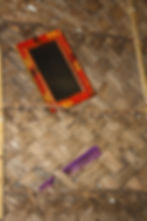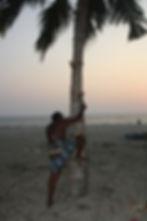My ideating process started with looking at the role of nature as a resource to Malabar culture and how it has influenced the way of life and identity of the communities residing there. I researched the significance of certain crops such as the banana plant, coconut, and palmyra and how they are incorporated in the everyday life of the people dating back to their history. I narrowed down to the Coconut palm, as it plays a notable role throughout South India.


The Sacred Seed
The coconut has become a cultural motif of India that is used in rituals, social and religious ceremonies and is associated with fertility, folk culture, totems, taboos, and beliefs. Its form so closely resembles a human head that the breaking of the coconut symbolizes the breaking of one's ego, while the water and kernel inside represent the purified mind. Tender coconut leaves are hung in line during festival time in Kerala, symbolically representing barriers restricting the entry of evil spirits. The coconut is an essential component of Theyyam, a ritual form of worship in the northern Malabar region, also known to be the ‘dance of the deities’. The Mudi (headdress), skirt, and the bust of female characters are made by cutting and painting coconut sheaths, shells, and fronds. Irrespective of their religion, fishermen offer the fruit to the rivers and oceans hoping for a bountiful catch and a safe return. Held in such high esteem the coconut is identified as Sriphala – The fruit of the Gods.
My aim was to gather information on the history of the coconut and its significance in Malabar culture starting from the origin of the palm and how it traveled to Kerala. Also, to document how different parts of the tree are used in daily life, livelihoods, rituals, celebration, cuisine, attire, and its relevance in the region’s Folklore. Much of my research was gathered through interviews and field visits to Kannur, Calicut, and Alleppey, Kerala, where I interacted with local families, artisans, a historian, members of the craft cluster that incorporate coir and visited the coir museum and the botany department at the Calicut University.
Alleppey, Kerala (March 19 – 20, 2015)
The city of Alleppey is the center for the manufacturing of coir. The coir board based in Alappuzha and Kochi is a statutory body established by the Government of India under the ‘Coir Industry Act 1953’ for the promotion and development of the coir industry in India. This trip was for me to interact with locals that have livelihoods centered around the coconut, to observe and document the coir cluster, and to procure coconut fiber that I could integrate into my work.

Weaving of palm leaves at Marari Beach, Alleppey

Woven coconut leaves used in interiors of rural homes

Costume of Theyyam dancer made from tender coconut leaves

Weaving of palm leaves at Marari Beach, Alleppey
Navigate arrows to view photos of field visits

Gandhi Smaraka Grama Seva Kendram, coir cluster (not for profit organization) in Alleppey

Coir godown in GSGSK


Gandhi Smaraka Grama Seva Kendram, coir cluster (not for profit organization) in Alleppey
Navigate arrows to view photos of Gandhi Smaraka Grama Seva Kendram
Toddy Tapping, Alleppey
Marari beach in Alleppey is a popular tourist destination, with crowds flocking towards it in the evening. Like several other beaches, its shore is scattered with coconut trees. I was fortunate to arrive there at a time when the toddy tappers were hard at work. Toddy, palm wine, or Kallu in Kerala is an alcohol made from the fermentation of sap collected from the coconut tree. Toddy tappers are usually from the Ezhava or Thiyya community hailing from the northern Malabar region. The new unopened buds of the palm flower are cut with a knife called Katiaal. The whole bud is then beaten with a hammer until swollen, then bound with tender coconut leaf and a paste of Taali leaf is applied on it. This is to prevent bacterial infections and the drying up of the bud. Sap begins to ooze after beating the bud for a week and can be collected twice daily. Initially, the sweet sap called Neera is non - alcoholic but is naturally fermented with sunlight to give Kallu. The sap is therefore collected before sunrise and after sunset.




Navigate arrows to view photos of toddy tapping at Marari beach, Alleppey
Inspiration
The idea of layers within layers fascinated me. I wanted to elaborate on the thought of how each part of this tree from its leaves to its roots can be further dissected to provide utility. Each layer has a distinct texture and color palette, yet come together to create what has come to be known as one of nature’s wonders.
The idea of the tree of life, a mythical majestic tree that has no particular reference but can be depicted in innumerable ways was my source of inspiration. It would allow me the freedom to translate, juxtapose, and create my own version of how I perceive the coconut tree to be the Kalpavriksha of the Malabar.
• This mythological tree is seen in Sanskrit literature, with its earliest sources seen in the Rig Vedas
• The Tree of life is the symbol of the creator
• The wish-fulfilling tree of knowledge
• It is believed to be the sacred tree connecting heaven and the underworld
• While there is no Sanskrit source conclusively identifying the tree with any real known tree, the Kalpavriksha can figuratively refer to a source of bounty.
• In Indian tradition, a tree is not just an object of nature but is treated as a shrine
• Each part of India has distinct trees that they regard to be sacred- Jasmine, Banyan, Bodhi, Mulberry, and Neem, etc.





I chose handloom weaving as my primary medium. The process of weaving though tedious is one of my favorite textile techniques. It provides great potential to play around with the material and achieve a range of textures. I used an 8 - shaft handloom to weave a range of samples taking the coconut’s outer shell, inner shell, fibrous husk, and white fleshy endosperm as my inspiration. As I wanted each sample fabric to be stiff and moldable, I wove copper wire as an additional weft. To weave my fabrics on a larger scale using a 12 shaft 50-inch wide handloom, I worked with Mr. Ashwath Narayan and his son Mr. Devaraja who hails from a family of handloom weavers. Though their practice is weaving traditional saris, it was an interesting collaboration and to be mentored by master craftsmen with decades of experience.
India has a unique heritage of handloom weaving. It is the second-largest employment-generating trade in the country, following agriculture. However, due to the lack of support and ineffective policies, this art is slowly dying out and being replaced by technologically advanced power-driven looms. One can definitely tell the difference between textiles woven by hand and by machinery. The handloom provides great potential to experiment and achieve a range of patterns and textures, both conventional and contemporary. I have great respect for the handmade, the slow and sustainable, and artisans keeping such craft practices alive.




I designed a cane structure for the organic form of my installation collaborating with Mr. Mukkaram, an artisan highly skilled in the craft of cane work. Cane is a material that is sturdy, strong, and can be bent into shape with heat.
The form comprises three parts that need to be assembled together.
Part 1
Convex – Outer murky green shell of a mature coconutConcave – Fibrous husk
Part 2
Convex – Fibrous husk (dark)Concave – Fibrous husk (light)
Part 3
Convex – Inner brown coconut shell concave – White flesh kernel
The three forms fit into each other and when viewed from above it resembles the layers inside a coconut. The woven textiles are draped and hand-stitched onto the cane frames, with a total of 8 weaves displayed. Coconut fiber is used as stuffing inside the structure to keep all three components at the same level when placed into each other.
The concept of a form that can be dismantled and reassembled is for –
• Easy transportation and storage of the structure
• Each woven textile to be viewed together and individually
• Variety in ways to display
The final structure comprises of three detachable parts and a stand to hold the structure steady:
Part 1
Width: 36”
Length: 48”
Height: 24”
Part 2
Width: 20”
Length: 30”
Height: 22”
Part 3
Diameter: 15”
Height: 18”
Stand
Width: 28”
Elevated height at the back: 6”
Height in the front: 1”



The addition of roots at the bottom of the fabric installation completes my vision of the Kalpavriksha. I experimented with different techniques such as coiling and braiding using coir rope of different thicknesses. I decided on using a technique of braiding 4 ropes together. The thickness of the rope was selected in proportion to the rest of the installation. The length of each braid is more than 3 meters each.
Digitally printed fabric panels accompany the installation. The panels are of length 48.5 “ and width 22”. There is a two-inch lining fold at the top and bottom of each of them for the insertion of 2 cane rods to hold the fabric in place. Taking into account that the exhibit is to be designed for a museum, I wanted the information panels to be integrated with the display. They are deliberately kept simple and organic to highlight the textile installation.












